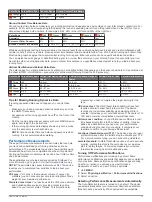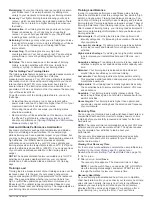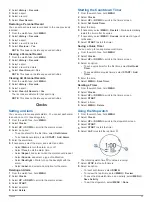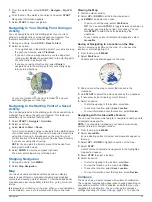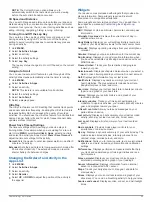
Maintaining
: Your current training load is enough to maintain
your fitness level. To see improvement, try adding more
variety to your workouts or increasing your training volume.
Recovery
: Your lighter training load is allowing your body to
recover, which is essential during extended periods of hard
training. You can return to a higher training load when you
feel ready.
Unproductive
: Your training load is at a good level, but your
fitness is decreasing. Your body may be struggling to
recover, so you should pay attention to your overall health
including stress, nutrition, and rest.
Detraining
: Detraining occurs when you are training much less
than usual for a week or more, and it is affecting your fitness
level. You can try increasing your training load to see
improvement.
Overreaching
: Your training load is very high and
counterproductive. Your body needs a rest. You should give
yourself time to recover by adding lighter training to your
schedule.
No Status
: The device needs one or two weeks of training
history, including activities with VO2 max. results from
running or cycling, to determine your training status.
Tips for Getting Your Training Status
The training status feature depends on updated assessments of
your fitness level, including at least two VO2 max.
measurements per week. Your VO2 max. estimate is updated
after outdoor runs or rides with power during which your heart
rate reached at least 70% of your maximum heart rate for
several minutes. The trail run and indoor run activities do not
generate a VO2 max. estimate in order to preserve the accuracy
of your fitness level trend.
To get the most out of the training status feature, you can try
these tips.
• At least two times per week, run or ride outdoors with a
power meter, and reach a heart rate higher than 70% of your
maximum heart rate for at least 10 minutes.
After using the device for one week, your training status
should be available.
• Record all of your fitness activities on this device, or enable
the Physio TrueUp feature, allowing your device to learn
about your performance (
Syncing Activities and Performance
).
Heat and Altitude Performance Acclimation
Environmental factors such as high temperature and altitude
impact your training and performance. For example, high
altitude training can have a positive impact on your fitness, but
you may notice a temporary VO2 max. decline while exposed to
high altitudes. Your MARQ device provides acclimation
notifications and corrections to your VO2 max. estimate and
training status when the temperature is above 22ºC (72ºF) and
when the altitude is above 800 m (2625 ft.). You can keep track
of your heat and altitude acclimation in the training status
widget.
NOTE:
The heat acclimation feature is available only for GPS
activities and requires weather data from your connected
smartphone. Full acclimation takes a minimum of 4 training
days.
Training Load
Training load is a measurement of your training volume over the
last seven days. It is the sum of your excess post-exercise
oxygen consumption (EPOC) measurements for the last seven
days. The gauge indicates whether your current load is low,
high, or within the optimal range to maintain or improve your
fitness level. The optimal range is determined based on your
individual fitness level and training history. The range adjusts as
your training time and intensity increase or decrease.
Training Load Balance
In order to maximize performance and fitness gains, training
should be distributed across three categories: low aerobic, high
aerobic, and anaerobic. Training load balance shows you how
much of your training is currently in each category and provides
training targets. Training load balance requires at least 7 days of
training to determine if your training load is low, optimal, or high.
After 4 weeks of training history, your training load estimate will
have more detailed target information to help you balance your
training activities.
Below targets
: Your training load is lower than optimal in all
intensity categories. Try increasing the duration or frequency
of your workouts.
Low aerobic shortage
: Try adding more low aerobic activities
to provide recovery and balance for your higher intensity
activities.
High aerobic shortage
: Try adding more high aerobic activities
to help improve your lactate threshold and VO2 max. over
time.
Anaerobic shortage
: Try adding a few more intense, anaerobic
activities to improve your speed and anaerobic capacity over
time.
Balanced
: Your training load is balanced and provides all-
around fitness benefits as you continue training.
Low aerobic
: Your training load is mostly low aerobic activity.
This provides a solid foundation and prepares you for adding
more intense workouts.
High aerobic
: Your training load is mostly high aerobic activity.
These activities help to improve lactate threshold, VO2 max.,
and endurance.
Anaerobic
: Your training load is mostly intense activity. This
leads to rapid fitness gains, but should be balanced with low
aerobic activities.
Above targets
: Your training load is higher than optimal, and
you should consider scaling back the duration and frequency
of your workouts.
Recovery Time
You can use your Garmin device with wrist-based heart rate or a
compatible chest heart rate monitor to display how much time
remains before you are fully recovered and ready for the next
hard workout.
NOTE:
The recovery time recommendation uses your VO2 max.
estimate and may seem inaccurate at first. The device requires
you to complete a few activities to learn about your
performance.
The recovery time appears immediately following an activity.
The time counts down until it is optimal for you to attempt
another hard workout.
Viewing Your Recovery Time
For the most accurate estimate, complete the user profile setup
(
), and set your
maximum heart rate (
).
1
Go for a run.
2
After your run, select
Save
.
The recovery time appears. The maximum time is 4 days.
NOTE:
From the watch face, you can select UP or DOWN to
view the training status widget, and select START to scroll
through the metrics to view your recovery time.
Recovery Heart Rate
If you are training with wrist-based heart rate or a compatible
chest heart rate monitor, you can check your recovery heart rate
value after each activity. Recovery heart rate is the difference
between your exercising heart rate and your heart rate two
minutes after the exercise has stopped. For example, after a
typical training run, you stop the timer. Your heart rate is
Heart Rate Features
17
Summary of Contents for MARQ DRIVER
Page 1: ...MARQ DRIVER Owner sManual ...
Page 6: ......
Page 51: ......
Page 52: ...support garmin com March 2019 190 02359 00_0A ...











